ーこんにちは。神山ものさす塾二期生の大村です。塾生になって約4ヶ月。塾のあと、どう暮らしていきたいのか?現在、塾生一人一人が模索しています。私自身、今年のはじめには、自分が徳島で過ごすようになるとは夢にも思っていませんでした。
神山ではイチョウの葉が少しずつ色づきはじめ、気温も低くなり、あたたかいものが恋しい季節になってきました。
私自身が神山ものさす塾に応募したきっかけを振り返り、塾生としての日々や塾生の今の様子をお伝えします。
今回の神山ものさす塾レポーター
-
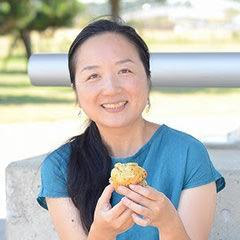
-
大村 陽子
春を告げる、梅の花が好きです(実と枝ぶりも)。現在、神山のなかでも「梅の里 阿川」と呼ばれる地に暮らしているのは、何かの縁なのか。音楽を聴きながらキッチンに立つと自由を感じます。材料を均等に切るのは、少し苦手です。
私が神山ものさす塾に惹かれた理由
私は広島市内で生まれ育ち、暮らしてきました。市内には6つの川が流れ、どこへ行くにもよく川を渡ります。気候の良い時は川沿いを歩いて通勤したり、ふとした時に河川敷で空を眺めたり。
いつもそばに川の流れを感じながら過ごしていました。

広島は川のたくさんある街です。
前職では、主に県内のさまざま地域で行われるイベントへ出向き、イベント限定のA3サイズの「特報」を作成する業務に関わっていました。イベントが終わるまでに当日の様子を写した写真を入れた「特報」を発行し、来場者に持ち帰っていただくというものです。
業務を行ううちに、さまざまな人に出会いました。なかでもイベント運営の中心には、地域に根ざした仕事をし、自分たちの町を良くしていこう、という思いを持った人がたくさんいることを知り、自分自身も仕事と暮らしをもっと近づけることができたらいいな、と思うようになっていました。
そんな時に出会った”神山ものさす塾塾生募集”の案内には、「ともに生きていきたい人たちと働く」という言葉がありました。「働く」というなかにも、そんな考えを持つことも有りなのか、という驚きと、こんな言葉が交わされる会社って、一体どんなところなんだろう?と好奇心がふくらみました。アナログ人間な自分に Web の勉強なんて、無謀かもしれない…。けれど、慣れ親しんだ仕事と環境を離れてみるのも、よい機会かもしれない。
思い切って応募を決め、塾生として過ごすチャンスをいただきました。
神山での暮らし 塾生としての日々
同じ西日本とはいえ、徳島県を訪れたことはなく、神山町は塾生になってはじめて訪れました。
傾斜の激しい山々に囲まれるようにして広がる町と、町を流れる透き通った鮎喰川は清流そのもの。雨が降ると山が霧に包まれる情景は「神の山」の名にふさわしく感じます。
塾生の女性チーム5人で暮らす古民家のシェアハウスには、私の長年の憧れの縁側があります。
8月の入居直後にエアコンが故障したため、涼を求めて縁側の近くに布団を敷いて眠るようにしていたのですが、自然と夜空を眺めて眠る形になりました。毎日、月が満ちていく様子を眺めたり、朝焼けに驚いたり。流れ星が本当に尾を引いて流れていくのを見たのも神山がはじめてです。
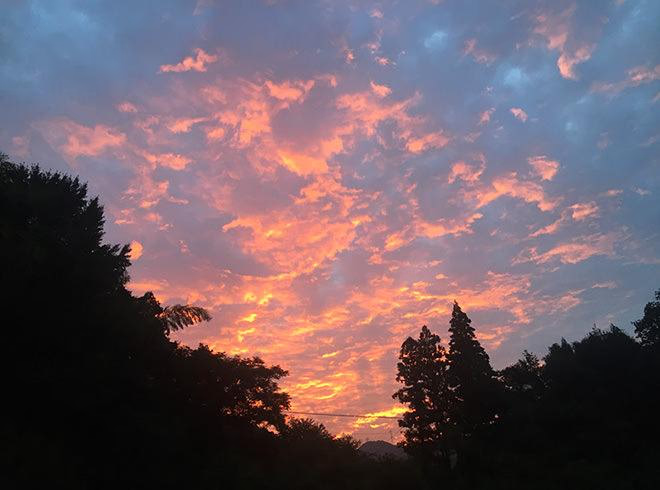
目覚めると、空に広がっていた朝焼け
そんな自然と近い環境で暮らしながら、日中はコーディング、ライティングを学んでいます。
東京やタイからコーディングやデザイン、運用、写真撮影やライティングなど、それぞれのプロが講師として神山に来てくださり、長年の業務で培われた経験やスキルを惜しみなく教えてくださるだけでなく、Web業界で働くうえでの心構えや「自由であるために大切なこと」など技術以外のお話も真摯にしてくださいます。撮影とライティングの講師の方が、それぞれ、撮影する対象や担当する物事を「好きになる」と言われていたのはとても印象的でした。塾生としての時間は、「働く」ということを再度考える機会をいただいているとも言え、本当に貴重な時間を過ごさせていただいていると感じています。
また、それぞれの講師の方がとても個性的です。夜遅くまで塾生の質問に答え続けてくださる方や、登山をされる方、スポーツ大会で誰よりも元気いっぱいに活躍される方…。仕事も生活も全力で楽しむ姿には刺激を受けます。当初の心配通り、たくさんの新しい知識に圧倒されて、立ち止まってしまうときもありますが、塾生や講師の方に、日々、助けられています。

厳しいながらも講師の「できるようになってほしい」という思いを強く感じたコーディングの講義
毎日のごはんづくり
シェアハウス生活では、私は主に晩ごはんづくりを担当しています。塾生の実家やご近所の方からいただく新鮮な(時には大量の)野菜や、道の駅で購入した神山の食材で日々の献立を組み立てています。5人分をつくるということにはじめはなかなか慣れず、時間がかかったり、失敗をしてしまったりすることもありましたが、どんなものでも、みんなが「おいしい」と言ってくれるのが嬉しくて、日々楽しく作らせてもらっています。
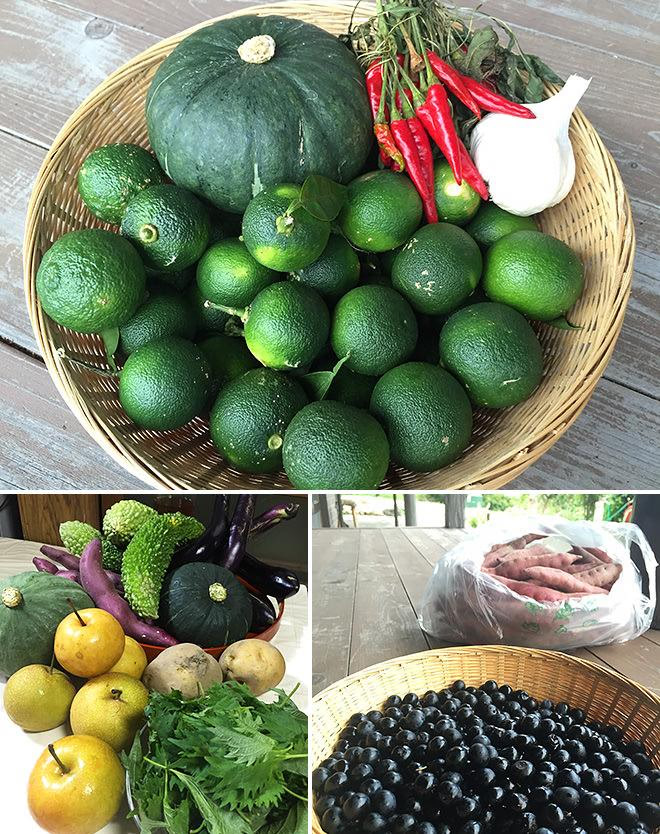
主に神山で収穫された、いただきもの
上:にんにく、すだち、とうがらし、南瓜
左下:夏にいただいたものたち。梨、じゃがいも、紫蘇、茄子、ゴーヤー、南瓜
右下:甘いさつまいもと山盛りのブルーベリー
縁側とともに憧れだったのが、畑のある暮らしです。家の畑で野菜やハーブを必要なときにささっと収穫して使えたらとても豊かだなぁ…と思っていたのですが、今回、実現することができました!台所の窓から見える畑に、ローズマリーやバジル、ブロッコリーや白菜の苗を植えたのです。毎朝、様子を見るのが日課になっています。豊富にある神山名産の「すだち」を美味しく食べることも日々の関心の一つです。梨や柿にかけるととても美味しいことを発見したり、オリーブオイルと庭にあるミントの葉を刻んでご飯に混ぜて食べてみたりと、オールマイティなすだちの虜になりつつあります。
特別なものを使ったりするのではない、日々の素朴なごはん作りですが、集中して受ける講義の合間に、神山の山々を眺めたりしながら「今日は何にしようかな」と献立を考える時間は、良い気分転換になっています。
神山は階段の踊り場みたいなところ
「神山は階段の踊り場みたいなところ」とは、神山に住む、神山塾一期生でもある好奇心旺盛なおかあさん、粟飯原(あいはら)国子さんの言葉です。
階段の途中にある踊り場で少し一休みをするように、神山で塾生として過ごす時間は、「今までの人生から一旦離れて栄養補給をし、新たな道をみつけていく時間のよう」と例えられたのです。
粟飯原さん自身、仕事と家事に追われる日々から離れ、イベント運営や森づくりに関わった、「デラックスな日々だった」という塾生生活を経て、小さなお店をもつという新たな人生をスタートさせた一人です。

「いつも直線に進むだけだときついから、”踊り場”で一服したら再出発して、いい人生をまっとうしてほしい」と笑顔いっぱいで話す粟飯原さん
私と同期で入塾したものさす塾塾生たちも、これまでの経験も年齢もさまざまです。それぞれが今までの暮らし方を離れ、正に、「踊り場」での日々を過ごしていると言えます。
「狩猟」が趣味という、私にとって驚きの趣味をもつ塾生は、神山の川にもぐってあめごなどの魚を仕留めた報告をよくしてくれます。大手企業で働きながら、週末には海や山での「魚突き」や狩猟を10年近く続けてきたといいます。今後は「自然のなかで自分の力で生きていきたい」という熱い思いを持っています。
子どものころに柔道を習い、男勝りだったという女性の塾生は、自分が女の子だからという理由で扱いが変わることに疑問をもっていました。社会に出て、働く現場で、女性だからこそ起きてしまう問題についての関心が高まり、「女性が働くこと」をライフワークにしていきたいと考えています。
1年近くアジアを巡る旅をした経験をもつ塾生は、新しく出会った人といつの間にか仲良くなり、ワイワイと楽しそうに話す姿をよく見かけます。旅を経て、「一見マイナスにしか思えない出来事も捉え方次第だと思うようになった」と話し、神山で出会う物事や自分自身の変化を積極的に受け入れていく姿にはいつも刺激を受けます。今後は何かを「つくる」ことをしていきたいと考えているようです。
Webのスキルプラスアルファ。それぞれが独自のアンテナを張り、神山にいるからこそできることを日々模索し、今できること、をはじめています。そんな挑戦の一つに、Webの講義と並行して行っている「地域コーディネーション」の授業の集大成とも言える「合同イベント」があります。
合同イベントに向けて、準備の日々
現在、私たち、ものさす塾塾生と、姉妹塾のような関係の神山KATALOGコース、リレイションさんの神山塾8期生は10月29日に古民家のゲストハウス山姥で開催する合同イベント「あるでないで神山」に向けて準備を進めています。
イベントでは、4班に分かれてそれぞれが考えた企画を行います。竹で家を建てようと、竹を切り出すところからはじめるチームや、来場者に足湯に浸かってリラックスしてもらいたいと足湯の設計から行っているチーム。それぞれが、アイデアや知恵を出し合い、神山の新たな魅力を感じてもらえたら、という思いで取り組んでいます。
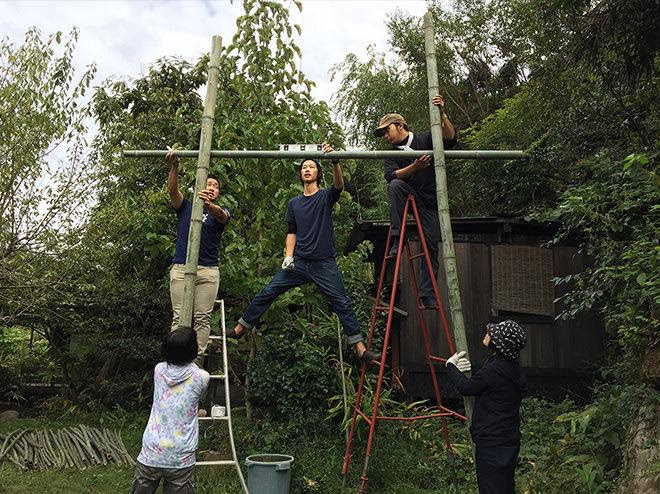
竹で家をつくるチーム
私の所属するチームは、神山の食材を使った食事を提供します。神山にある食材を自分たちなりに工夫して調理することで、イベントに訪れた神山在住の方にとっては再発見、神山が初めての方には新しい発見になるものを提供できたら、と試作をしたり、神山の色々な方からお話しを伺ったりしています。
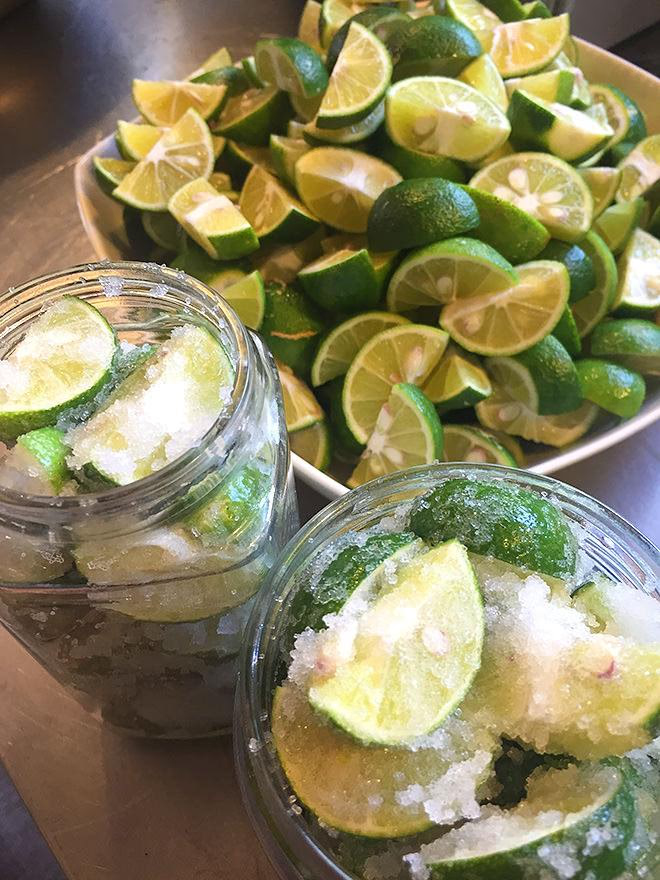
緑色の宝石のように輝く仕込んだばかりの「塩すだち」
先日はご近所の方のお家で、「塩すだち」づくりをしました。神山の名産品であるすだちと塩をあわせて瓶詰めにするという簡単なものですが、塩レモンのように魚や肉料理で使ったり、ソースにしたりと活用方法はさまざまです。
また、すだちと柚子の間のような、10月後半に旬をむかえる「柚香(ゆこう)」を育てている農家さんも訪ねました。見た目はすだちに似ていますが、すだちより少し大きく、実はみかんのようにオレンジ色になり、甘みもあるようです。既に表皮は良い香りで、イベントで何かしら使えたら…と思案中です。柚香の木の下にはミョウガの花が咲いていて、採れたてのミョウガもいただきました。お話しを伺ううちに、食材のことにとどまらず、食にまつわる子どもの頃の思い出話などもしていただきました。
イベントで提供するドリンクのために、すだちや柚子のシロップ漬けの作業も行っています。皮をむいたすだちの輝く美しさにみとれて「すだちゴールドだ!」などと言いながらみんなで作業を進めています。

柚香農家さんに畑を案内してもらいました。

すだちゴールド!
塾生になって4ヶ月 私の変化
決して上手なわけでもなく、知識もそんなに豊富ではありませんが、私はキッチンに立つのが好きなのだな、と神山に来て改めて思いました。神山に新鮮で美味しい野菜がたくさんあることや、農家を訪問したり、塾生にごはんを作らせてもらったり。「あれが食べたい」などのリクエストや思いがけず大量の食材をもらうと、ついつい台所でなにかしたくなってしまう自分がいます。たくさんの人に食べてもらう、というのは以前の私には少し抵抗のあることでしたが、気付けば毎日のことになりました。
思えば、私は考えすぎて煮詰まるところがあり、姉に「石橋を叩きすぎ」と言われたこともあります。ですが、最近は少し変化を感じています。塾生という、特別な状況にいることや、神山という自然豊かな環境にいるからなのか、はたまた、講師の方や神山で出会う「自分の力で生きている人」に触発されるからなのか。考えてから「やってみる」までのハードルが低くなってきているように感じます(やっぱり少し勇気はいりますが)。
塾生としての生活はあと2ヶ月半。塾生だからこそできること、神山にいるからこそできることに、できる限り心のハードルを低くして、チャレンジしていきたいと思っています。
あるでないで神山 イベント概要

- 日時 10月29日(土) 11:00~18:00
- 場所 ゲストハウス山姥
- 住所 徳島県名西郡神山町阿野字神木192-1
10/29(土)に、1日限定の「やまんば村」を開村!
地域に可能性を求めて神山に集まった「神山塾」と「神山ものさす塾」の塾生が、古民家ゲストハウス『山姥』を舞台に、神山の魅力がギュッとつまった村を作り上げます。
塾生各々が感じた、神山にはこんなに素敵なものがあるじゃないか(「あるでないで!」)という発見、そして気づき。
神山のそのままの魅力をもっと知ってもらいたい!
そのような想いから、塾生が神山で発見したヒト、コト、モノの「ええやん!」を、『家・食・湯・茶』の4つのテーマで表現します。
10/29は、“やまんば村”の村人になった気持ちで、ゆるりと過ごしてみませんか。
facebookページはこちら
おまけ
神山の秋を感じるごはん おいのこ寿司の作り方
秋の収穫を感謝する10月の「亥の日」に、各家庭で作られてきた神山の家庭料理です。
農作業の忙しい日々に、この日だけはおいのこ寿しを作ってゆっくりと家で身体を休めよう、という意味もあったと農家の方から教えていただきました。
酢の代わりに柚子果汁を使ったすし飯に、さといもや大根などを煮たものを混ぜ込むばら寿司です。今回は柚子のかわりに神山名産のすだちを使い、彩りに錦糸卵をのせてみました。写真では、ミョウガを刻んだものものせています。
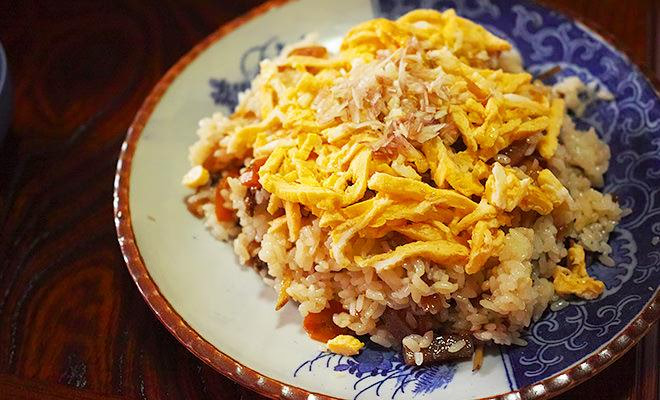
<酢飯>
- お米…4合
- すだち果汁(柚子果汁でも)…120cc(5〜6個分)
- きび砂糖…大さじ4
- 塩…小さじ2
<お寿司の具材>
- にぼし…50グラムを使い、約600mlの出汁をつくる
- 醤油…大さじ4
- みりん…大さじ2
- きび砂糖…大さじ3
- にんじん…1/2本 短冊切り
- さといも…4個 厚めのイチョウ切り
- 大根…小ぶりのもの1/4本 短冊切り
- こんにゃく…1/2枚 さっと茹でて拍子切り
-
油揚げ…1枚 短冊切り
※少し甘めです。調味料はお好みで調整してください。
<錦糸卵>
- 卵…2個
- みりん…大さじ1
準備
- お米を炊く。
- にぼしで分量の出汁をとっておく
- にぼしの出汁の鍋に、にんじん、さといも、大根、こんにゃく、油揚げを入れて煮る。醤油ときび砂糖、みりんを入れて味を整える。
- 具材を煮ている間に錦糸卵を焼く。卵にみりんをいれて混ぜ、フライパンで薄く焼く。焼き終わったら、くるりと丸めて細めに切る。
- 酢飯用のすだちを絞り、砂糖と塩を混ぜておく。
- ごはんが炊けたら、3 を混ぜて、あたたかいうちに具材も混ぜこむ。
-
最後に錦糸卵をのせて完成です!
ポイント
にぼしのしっかりとした出汁で作ります。
すだちをカットしたものを添えて、お好みでキュッとしぼっていただくことをおすすめします!

